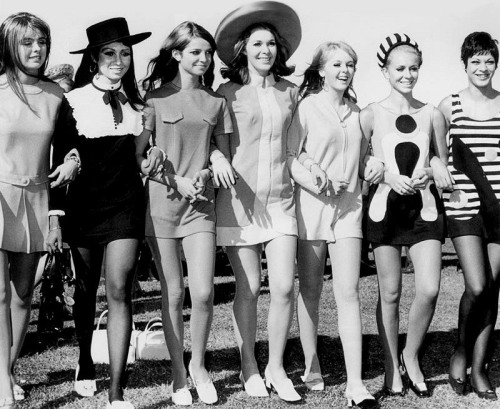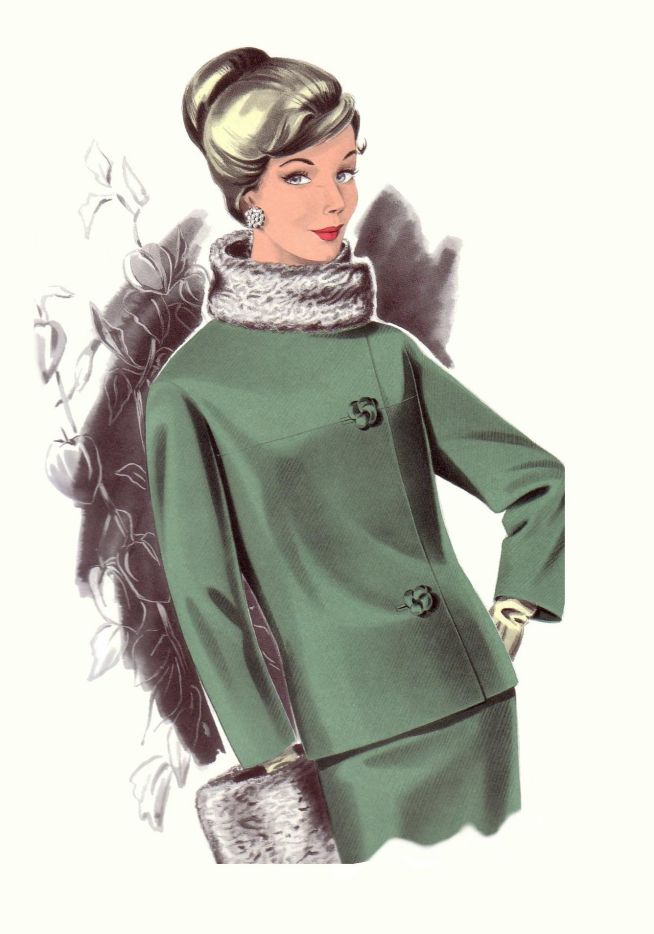1960 began a decade which may well
be recorded as one of the most fashion-conscious periods in recent
history, challenging the 1890s and the 1920s. Even the American
Presidential election campaigns made fashion an issue, when the wives of
the two Presidential candidates became the storm center of a headlined
controversy over the source and cost of their respective wardrobes,
their taste in clothes, and their comparative rating among the
international "best dressed."
Two main changes in coat fashions marked the year:
emphasis on shorter coats and the reemphasis on sweepingly full coat
shapes. On both sides of the Atlantic, all uncertainty disappeared as
the public showed unqualified acceptance of relaxed shaping and the
lowered waistline. collections in both Europe and America concentrated
on low-waisted silhouettes and also reintroduced the princesse shape and
the narrow tubular or oval outline with little or no waistline
indentation. Even the most cautious women seemed willing to accept the
overblouse (as comfortable to wear as it is fashionable) as a becoming
change from the fitted bodice and constricting belted waist.
New types of soft fullness appeared:
sometimes it was "full over full" expressed in loose box jackets over
full skirts, or again in deeply bloused tops over circular skirts.
Unusual "directional" seaming was employed to shape dresses and coats so
as to achieve a full-flowing outline yet retain figure contours.
Side-slanting folds, side fastenings on coats and dresses, side-to-side
necklines, and a sideward plunge to daring evening necklines also
pointed up the abstract effect in fashion, as opposed to a "period"
look.
Fashion Capitals. 1960 was
a year when the different capitals of world fashion, Paris, Rome, and
New York, seemed to have clearly established their own independent
points of view. Although France and Italy continued to wield great
influence on the popular-priced American fashion industry, by being
copied and publicized in line-for-line copies made in America and also
by means of the fast-developing European ready-to-wear industry, a
well-recognized group of American designers exercised profound
influence, both in their original collections and the copies made of
their clothes. In New York, Norman Norell caused a worldwide flurry when
he showed suits with tailored trousers and culottes replacing the usual
skirts. They were worn by mannequins with the darkened eye-lids,
whitened make-up, and cropped hair of the 1920s. The Trigere collection
in New York and the Galanos collection designed in California both
included clothes with a slender, pliant, and flowing medieval echo which
the fashion world cited as prophetic. Bill Blass of Maurice Rentner and
Donald Brooks of Townley led a group of American designers in launching
modern versions of the deeply bloused, bias-cut, low-waisted clothes of
the 1930's.
The annual Coty American
Fashion Critics' Award, most coveted honor in contemporary fashion
because it is bestowed by a jury of more than 70 fashion editors, went
in 1960 to four designers whose varied backgrounds reflect the multiple
nationalities combined to form the new force of American fashion: young
French-born Jacques Tiffeau (coats and suits), Italian-born Ferdinando
Sarmi (afternoon and evening clothes), Austrian born Rudi Gernreich
(bathing suits), and New Yorker Roxane of Samuel Winston (evening
clothes).
In Paris and Rome
designers continued to stress the abstract oval and tubular shapes, with
high pointed hats, wide collars, armholes of almost cape-like depth,
and skirts with fullness above a tapered hemline. The Paris versions
expressed by Dior and Balenciaga counterbalanced a slender tube with a
"bubble" skirt beginning below the hipbone. Rome designers such as
Simonetta and Fabiani built their silhouettes on the unbroken oval shape
with rounded width at the top and a very narrow hemline. Skirts in
Europe were noticeably shorter than the standard American length.
Day clothes remained simple and colorful.
Sleeveless dresses dominated the smart collections, usually covered by
jackets or coats to form a costume. Many clothes abandoned collars in
favor of contrasting colored piping which also edged the jacket and
pockets or cuffs.
Layered effects were important in fashion: tunic tops, tiered skirts, and hem flounces were strongly shown. Many designers used double layers of chiffon or print covered with organza to form a dress or a costume.
The first half of the Sixties resembled the Fifties.
Conservative, ladylike, proper. No short skirts. Gloves for evening and social
occasions. Petticoats and girdles.
The dresses at left and below with
their swing, pleated or pencil skirts could easily have been worn in the
1950s.
Women wore dresses or skirts for all but the most casual
activity. Pants were for sport or play and never worn to
school.







No comments:
Post a Comment